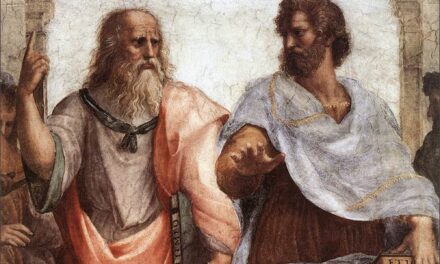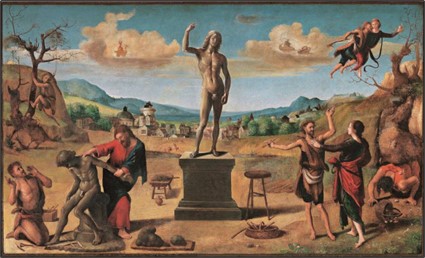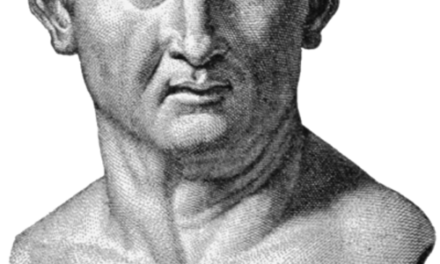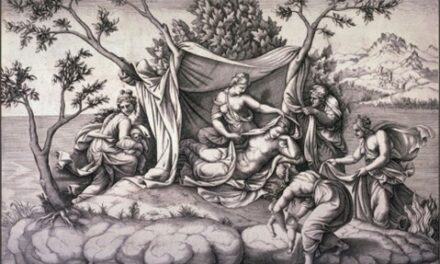It is correct, yes, to speak of Eleusinian Mysteries, but we should – in a broader sense – speak of Eleusinity.
The deepest roots of Eleusinity lie in the culture and civilization of the ancient pre-Greek people of the Aegean Sea; they were all ethnically similar populations, characterized by black hair and olive complexion, who, since the most remote times, inhabited the Cyclades islands, Crete, continental Greece and the coasts of Asia Minor. These populations were all part of the Cretan Empire of the Minos, and, above all, had two elements that united them: the cult of the ancient Titan Gods (overthrown, according to Hellenic tradition, in a war called Titanomachy by Zeus and the new Olympian Gods) and the designation of their progenies through the female line (Matriarchy). Another underlying line of their culture was the common identification with the same sacred lineage, heir to a grandiose previous civilization.
With the collapse of the Minoan Empire, which occurred around 1,500 BC, and with the descent from the North (Danube plain, present-day Ukraine and the Caucasus area) of new populations who were ethnically and culturally foreign to the Aegean area (Achaeans, Aeolians, Ionians, Dorians, etc.), all enslaved to the cult of those that the Aegeans considered “usurper” Gods, a great phase of tension and struggle began which reached its peak in 1,184 BC, with the conclusion of what is commonly known as the Trojan War.
The latter was not simply a conflict dictated by commercial reasons or by a mere desire for conquest, but rather a war that saw two completely different and irreconcilable worlds pitted against each other: on one side a coalition of invading populations united by the cult of the new usurper Gods, determined to annihilate everything that did not conform to their own vision of the world; on the other the last bastion of the Aegean-Minoan culture, a union of similar populations whose intent was to strenuously defend their own cultural and religious identity (the cult of the ancient Titan Gods) and their own heritage of values.
With the disastrous fall of Troy, that was the greatest religious and cultural center of the Lelegic-Pelasgian and Aegean populations, the great heritage of wisdom of these civilizations was secretly transferred to Attica, in a small town overlooking the Gulf of Salamis: Eleusis. It is here, in fact, that Tradition says that the Titan Goddess Demeter arrived, incarnated in human guise, in search of her daughter Kore, taken away from her by the Olympian Gods – on the orders of Zeus – to prevent her mission of redemption of humanity from being fulfilled. And it is also here, in the same year of Her arrival (1,216 BC) that the Goddess instituted the Sacred Mysteries, pronouncing the Discourse of Revelation. From that moment on, Eleusis became the greatest point of reference for all those who recognized themselves in the “One and True Faith”, or in the cult of the ancient Titan Gods, becoming a center of initiation and cultural irradiation without precedent in the ancient world. So much so that, from all over the then known world, they began to go there in thousands to be initiated. And, by extension, throughout the then known world, Eleusinian Temples and Sanctuaries began to arise and prosper.
Eleusinity gradually expanded, through various historical phases, reaching all the coasts of the Mediterranean and all the regions of Europe, up to the misty lands of the North. There is, in the Eleusinian context, a precise schematization of these phases. The phase preceding 1,216 BC is called the phase of the “Proto-Eleusinian Consciousness”. It was followed by the phases called “Old Eleusinian” (1,216 – 780 BC) and “Middle Eleusinian” (780 – 360 BC), in which the progressive expansion of the cult towards the Western Mediterranean, Sicily, Magna Graecia and the coasts of North Africa began. Then, there was the phase called “New Eleusinian” (360 BC – 50 AD), during which there was the great propagation of the cult in all the territories subject to Rome. Finally came the phase called “Late Eleusinian” (50 AD – 380 AD), during which there was the maximum expansion of the cult among the popular classes of the entire Empire, but which also saw the beginning, with the seizure of power by the Christians, of the great persecutions against all the ancient religions, including the Eleusinian one. Persecutions that culminated in the year 395, with the desecration and definitive destruction of the Telestérion and the other sacred places of Eleusis.
The origin of the Sacred Mysteries is therefore to be found in Crete and not in Egypt, as many historians of religions have erroneously written and hypothesized, based on the misleading interpretation of some passages in the works of Diodorus Siculus and Iamblichus. As the origin of the cult of the Two Goddesses, the Mother and the daughter, is in Crete. The Eleusinian Mysteries spread, yes, also in Egypt, but they were officially instituted there in a late period, under the reign of Ptolemy I, thanks to the intercession of the Hellenistic sovereign (who had been initiated there) and of the Prytan of the Hierophants of the time, the Eumolpides Timotheus, who, as Tacitus attests, came specifically from Eleusis to Alexandria to solemnly preside over the Rites[1].
As Enzo Lippolis[2] points out in relation to the Cretan origin of the cult, historical testimonies explicitly speak of the Mediterranean island in relation to the development of the Eleusinian mystery ritual forms.
In the Homeric Hymn to Demeter, when «the daughters of Celeus, son of Eleusis»[3], having arrived near the sacred Kallichoron spring to draw water, not recognizing the true divine nature of the Goddess, question her about her identity, she answers them: «Gift (Δὼς) is my name: so indeed, my venerable mother called me; and from Crete, on the broad surface of the sea, I came without wanting it. With violence and coercion, against my desire, the pirates took me away»[4], thus attesting – both symbolically and materially – her origin from the sacred land of the Minos.
Regardless of the indication contained in the Homeric Hymn to Demeter, according to which the Goddess arrived in Eleusis incarnated in the guise of an old woman coming from Crete, what Diodorus Siculus writes is fundamental, confirming that according to the Cretans of his time «the mysterious initiations from Crete were transmitted to other men» and continues by maintaining that «the initiation celebrated in Eleusis by the Athenians, almost the most famous of all, that of Samothrace and that celebrated in Thrace among the Ciconians (…) are all transmitted in secret, while in Knossos, in Crete, since the most ancient times there was the custom of celebrating these initiations openly for all, and the Mysteries, which among other peoples are celebrated with the prohibition of being revealed, among them were not kept hidden from anyone who wanted to have knowledge of them»[5].
Diodorus, who presumably was not initiated into the Eleusinian Mysteries and who in many passages of his works also commits not insignificant interpretative errors regarding Eleusinity, here instead affirms an important double truth. Namely, not only that the Eleusinian Mystery Tradition and its rituals have their roots in the Minoan civilization of Crete, but also that, in that historical phase prior to 1216 BC which in the mystery sphere is called the “Proto-Eleusinian Consciousness”, the Rites were not cloaked in the rigorous secrecy and vow of silence that later distinguished them. The cult, in fact, necessarily became mysterious only after the abduction of Kore and the arrival of the Goddess Demeter in Eleusis, who there, in 1216 BC, institutionalized the Rites under this new guise to defend and protect the Tradition and a complex heritage of wisdom that otherwise, due to the changed historical and political conditions, risked being destroyed or, even worse, falling into enemy hands. Therefore Victor Magnien is perfectly right when he states with conviction that «the Mysteries of Eleusis are a new form of a cult that is in reality very ancient»[6].
This is a factor that has been recognized and confirmed also by the Hungarian historian of religions Károly Kerényi, who in one of his essays wrote: «In antiquity the Cretan origin of the Eleusinian, Samothracian and Thracian – that is, Orphic – Mysteries was recognized in the fact that in Knossos (…) everything that was kept secret in those other Mysteries was openly accessible to everyone»[7].
In reality, things were not exactly in the simplistic terms expressed by Kerényi (a historian who, in my opinion, often fell into gross interpretative errors), since in Crete and in all the territories under the control or influence of the Minoan Empire the religious teachings, although – as we have said – less cloaked in secrecy and vows of silence – were not easily accessible or impartible to foreigners.
The exquisitely Cretan origin of the Eleusinian Mysteries is also fully attested by archaeological finds and numerous other pieces of evidence. Already in 1934, the great Swiss Hellenist Georges Méautis, professor at the University of Neuchatel and a Pythagorean initiate, wrote in his treatise Le Mystères d’Eleusis: «The Telestherion, or initiation hall, has an architecture essentially different from that of other Greek temples in general: in reality, it is a large hall surrounded by steps on which the initiates sat, with the roof supported by a certain number of columns placed inside. Where should we look for the origin of this very particular construction? Most likely in Crete. The French excavations of Mallia, in fact, have brought to light a hall of considerable size that seems to have been the prototype of the Telestherion. This room measures ten meters in length, is supported by six columns and is preceded by a vestibule. Furthermore, a room in the Palace of Knossos, called the “Crypt of the Pillars”, has a similar layout. (…) It is therefore not surprising that the particular layout of the Telestherion also came from Crete»[8].
The great Italian archaeologist Carlo Anti, professor and rector of the University of Padua, also came to the same conclusions a few years later, in 1943. Anti, starting from a completely different point of view, that is, from the study of the theatrical structures of the first and second Palace of Phaistos, of the second Palace of Knossos, of the theatrical tribune of the square of Gurnià and of the theatrical steps of the Agora of Lato and from the influences they had on the first known examples of Greek theatre, came to find and document the direct derivation, both stylistic and architectural, of the first phases of the Telestherion of Eleusis from these buildings[9].
Moreover, it is not only perfectly plausible, but even obvious that the same cultural, sacred and religious basis, such as that which characterized the Minoan-Cretan civilization and that which determined the rise of Eleusis and its Sacred area, gave rise to the construction of temple and ceremonial structures built with the same architectural criteria, with the same forms and with the same functions. And the Telestherion of Eleusis, it must be remembered, was not properly or limitedly a Temple intended for the cult of a particular Deity, but – and this is its absolute peculiarity – a sacred building intended for Initiation ceremonies and for this purpose conceived and designed to accommodate numerous people, the place where the initiates received a real ritual death and were reborn to a new life, after having met, physically and tangibly, the Deities.
Already twelve years before the publication of Méautis’s essay and twenty- one years before the publication of Carlo Anti’s first conclusions, in 1922, the great Swedish archaeologist Axel Waldemar Persson (1888-1951), confirming the direct derivation of the Eleusinian Mysteries from Crete, already attested in the 19th century by the German philologist and mythologist Georg Friedrich Creuzer (1751-1858)[10], thus summarizes his point of view on the question:
«In my opinion, the following points, which briefly summarize the results of our research, support the correctness of the thesis according to which the Mysteries have Cretan origin:
- the oldest Telestérion is pre-Hellenic;
- the name Eleusis refers to pre-Hellenic Crete, and certain vases for ceremonial use, the kernoi and the sprinklers for sacrifices, are used both in the Eleusinian and Minoan cults;
- the shape of the Telestérion is certainly a development of the so-called Minoan theatres;
- the Anàktoron is identical to the Cretan repositories;
- the purifications of the Eleusinian cult come from Crete, where they originally belonged to the Minoan tradition;
- a double ancient tradition derives the Mysteries from Crete: Diodorus is independent of the Homeric Hymn to Demeter, while Isocrates (Paneg., 28 b) depends on it, as do Dionysius of Halicarnassus (I°, 61) and the Scholia of Servius»[11].
[1] Publius Cornelius Tacitus: Histories, IV°, 83.
[2] Enzo Lippolis: Mysteria: Archaeology and Cult of the Sanctuary of Demeter at Eleusis. Ed. Bruno Mondadori, Milan 2006.
[3] Homeric Hymn to Demeter, 105.
[4] Ibidem, 121-124.
[5] Diodorus Siculus: Historical Library, V°, 77,3.
[6] Victor Magnien: Les Mystères d’Eleusis. Ed. Payot, Paris 1938.
[7] Károly Kerényi: Dionysus: Archetype of Indestructible Life. Ed. Adelphi, Milan 2010.
[8] Georges Méautis: Les Mystères d’Eleusis. Ed. de la Baconnière, Neuchatel 1934.
[9] Carlo Anti: Eleusis and the Greek theatre. Ed. R. Accademia d’Italia, Rome 1943.
[10] See A Körte: Archiv. für Relig., XVIII°, 1915, p. 118.
[11] Axel W. Persson: Der ursprung der Eleusinischen Mysterien (Archiv fü Religionwiss, 1922, p. 308).








